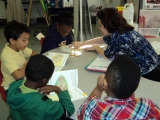-
Category 1
Selected in 2014
-
Grades: pre k - 4
School Setting: rural
Town Population: 9,290
Student Enrollment: 566
Student Demographics:
Black/African American: 22%
Teacher/Student Ratio: 1:20
White/Caucasian: 55%
Hispanic: 15%
Hawaiian/Pacific Islander: 0%
Asian: 1%
Native American: 1%
Other: 0%
% Reduced Lunch: 75%
% ELL Learners: 15%
Founded: 1951 -
PRINCIPAL:
Alicia Vosburgh -
CONTACT:
606 Gray Road
Chocowinity, NC 27817
252-946-3881
avosburgh@beaufort.k12.nc.us
Chocowinity Primary School
Chocowinity, NC
Our philosophy of school change and improvement is to embrace the whole child, including social, emotional, and physical needs so they are ready to learn. We believe in "catching students before they fall" behind academically by consistently holding high expectations for all students and celebrating success. Relationships are built with the entire family to provide support and give our staff a platform that leads to student growth and achievement.
- Describe specific programs in place to ensure that families are involved in the success of your school and students.
- Family and community engagement begins by analyzing feedback from annual surveys on school wide programs, classroom strategies, and overall performance. Parents are highly encouraged to attend school events as well as School Improvement Team meetings and district board meetings to voice concerns or offer insights. We continue to enhance student success by hosting curriculum events such as open house, curriculum nights, parent teacher conferences, academic workshops, and summer book club so families are equipped with resources to aid in literacy and math practice at home. We focus on a home school connection by sharing news and assignments using technology tools such as websites, blogs and wikis. Parents have at home access to programs such as Accelerated Reader/Math, Envision Math, Study Island and Reading Eggs for monitoring progress and extra practice. Through parent portal, families are encouraged to monitor student data daily in order to uphold student accountability and success.
- Describe the most successful activity your school has initiated to strengthen ties to your community.
- Our school strives to organize a variety of activities that will strengthen our ties in the community. One of the most successful activities we have hosted is the Father/Daughter Dance and The Mother/Son Date Night. These two events do not focus on academics, but on the whole child and the home life in which they live. The events strengthened relationships with care givers whom rarely visit the school and others within the community. Businesses in our community helped sponsor these events by providing a location, music, food, gifts, and other needed items. The children had the opportunity to celebrate a fun night with someone special in their lives while our staff had the opportunity to network with students, families, and community members.
- Describe your philosophy of school change or improvement.
- Our philosophy of school change and improvement is to embrace the whole child, including social, emotional, and physical needs so they are ready to learn. We believe in "catching" students before they fall behind academically by consistently holding high expectations for all students and celebrating success. Relationships are built with the entire family to provide support and give our staff a platform that leads to student growth and achievement.
- What are your school’s top two goals for the next year?
- Through consistent PLC meetings, our staff continuously analyzes student progress, instructional strategies, and interventions to identify areas of improvement for sustaining student growth and performance. Our first goal is to incorporate research proven and appropriate intervention programs for individuals with disabilities in all academic areas. These programs will need to be unique to qualifying students and not currently be used in the regular education classroom. Our goal is to close the achievement gap and mainstream students with disabilities back into the regular education classroom for their core instruction at a faster pace. This will allow instructional time spent with special education teachers to be more tailored to the needs of select students and reduce the teacher-student ratio. Our second goal is to continue to sustain growth and academic achievement by adjusting initiatives as needed and ensuring rigorous classroom instruction is delivered for all types of learners.
- What is the single most important factor in the success of your school that others could replicate?
- The single most important factor in the success of our school is accountability. Administrators, teachers, students, and parents have a mutual understanding that all are responsible for student well-being which has a positive impact on student success and performance. Our teachers are dedicated to identifying the needs of all students and are passionate about differentiating instruction. This process begins with administrators setting guidelines for classroom instructional strategies. Formative assessments are used to create a data wall which is a visual method for tracking individual student achievement and identifying areas of strengths and weaknesses. All staff are held accountable for continuing to collaborate, monitor student data, choose or adjust initiatives, and implement rigorous classroom instruction to sustain high performance.
- Describe the program or initiative that has had the greatest positive effect on student achievement, including closing achievement or opportunity gaps, if applicable.
- The initiative that has had the greatest positive effect on student achievement is our K-4 literacy model, including a balanced literacy approach, which coincides with selected programs that uphold high expectations and emphasizes the need for effective instruction to close the achievement gap. This model is composed of small group guided reading and writing lessons, tailored to specific needs of the individual learners.Daily instructional activities are used to encompass the five domains of literacy including vocabulary, phonemic awareness, phonics, comprehension, and fluency. Our recent focus has been on providing multiple opportunities to read continuous leveled texts and provide a written response to recognize reciprocity in literacy while improving higher level critical thinking skills.
- Explain how Title I funds are used to support your improvement efforts.
- Title I funds are used to provide necessary resources in the classroom to accommodate academic needs. Full time Reading Specialists are funded to provide intervention initiatives for at risk students across all grade levels, in addition to teaching professional development sessions, coaching, modeling, and offering literacy support to teachers on campus and in the district. Our funds also employ personnel on a part time basis to tutor second, third and fourth grade students to provide additional practice on critical skills and ensure mastery learning. To maintain highly qualified teachers with the most current knowledge, funds are also used to send teachers to local, state, and national conferences to further support instruction in all academic areas. By understanding the value in parent Involvement, we use funds to host curriculum and enrichment events that will provide academic support, workshops, and resources for families while highlighting student achievement.
- Identify the critical professional development activities you use to improve teaching and student learning.
- Professional development needs are based on state/district initiatives, formative assessment data, individualized teacher professional development plans, and administration recommendations. As we continue to implement our Literacy Model our focus is on developing strategic readers, increasing comprehension skills, and enhancing written response to text. This implementation began three years ago with grade specific guided reading training including a writing component. The progression continued with additional "refresher" sessions, modeling lessons in classrooms, routine observations, and providing guidance for new staff. In order to stay up to date with current literacy theories and research based strategies, staff attend local, state, and national conferences to apply new knowledge within the Literacy Model. We continue monitoring growth patterns of teachers and students in order to select appropriate professional development sessions to meet goals and sustain high achievement.
- Describe how data is used to improve student achievement and inform decision making.
- Our school uses multiple assessments in order to make well-informed instructional decisions. By collecting data on students’ attendance, behavior, and performance, we are able to view the whole child and select initiatives that will best meet the needs of the learner. Data from formative assessments is placed on a Data Wall with statewide criteria and critical skills indicated. Staff collaborates in PLC meetings to review this data and any additional assessments to ensure that all students are receiving the appropriate instruction or intervention program. Collaboration continues at weekly grade level PLCs, monthly SIT meetings, quarterly data meetings, bi-annual vertical planning meetings and Student Support Team meetings. Any student that is not proficient according to state assessment standards in all grades is considered at-risk at any time during the school year and targeted for assistance to ensure that all students are successful.
- Describe your school culture and explain changes you’ve taken to improve it.
- Our school culture encompasses trust, respect, and appreciation among students, families, staff, and community members with an "open door" policy where all feel welcome and safe. As a Pre-K through 4th grade school, the opportunity to serve families for five years creates positive relationships that foster parent involvement, collaboration, student success, and motivation. Enrichment events and home/school connections continue to be improved each year to promote networking, communication, and showcase student achievement. Our school establishes professional learning communities that encourage teachers to effectively communicate, share expertise, work together productively, and voice concerns constructively. Important leadership decisions are made collaboratively with input from staff members, students, and parents. Most importantly, our school works as a team, celebrates success, and provides understanding for both students and staff to learn and grow together.
Stats
-
Category 1
Selected in 2014
-
Grades: pre k - 4
School Setting: rural
Town Population: 9,290
Student Enrollment: 566
Student Demographics:
Black/African American: 22%
Teacher/Student Ratio: 1:20
White/Caucasian: 55%
Hispanic: 15%
Hawaiian/Pacific Islander: 0%
Asian: 1%
Native American: 1%
Other: 0%
% Reduced Lunch: 75%
% ELL Learners: 15%
Founded: 1951 -
PRINCIPAL:
Alicia Vosburgh -
CONTACT:
606 Gray Road
Chocowinity, NC 27817
252-946-3881
avosburgh@beaufort.k12.nc.us











